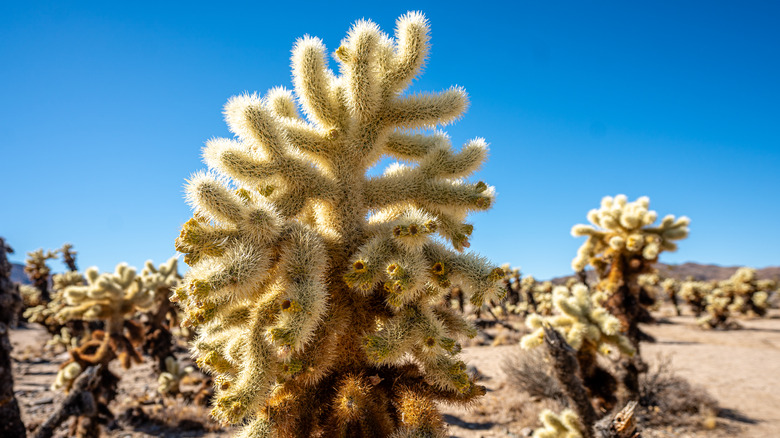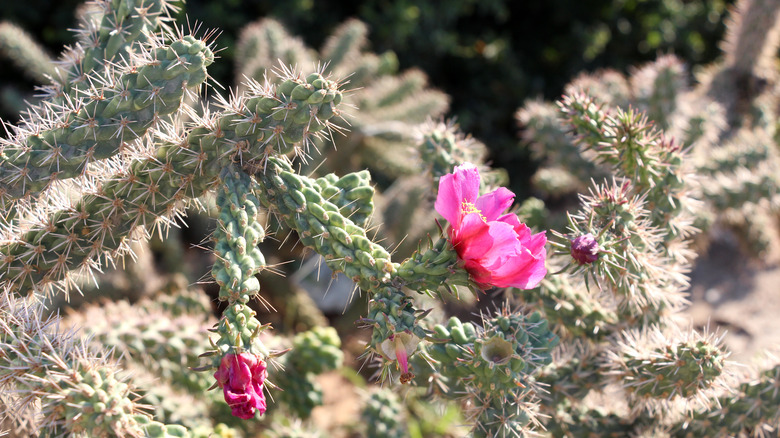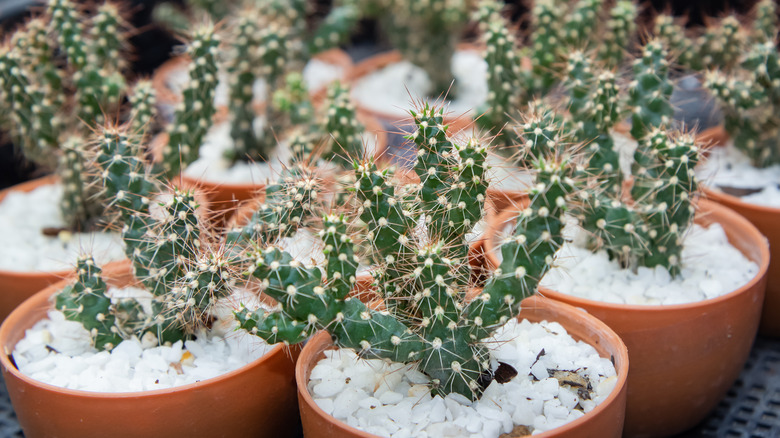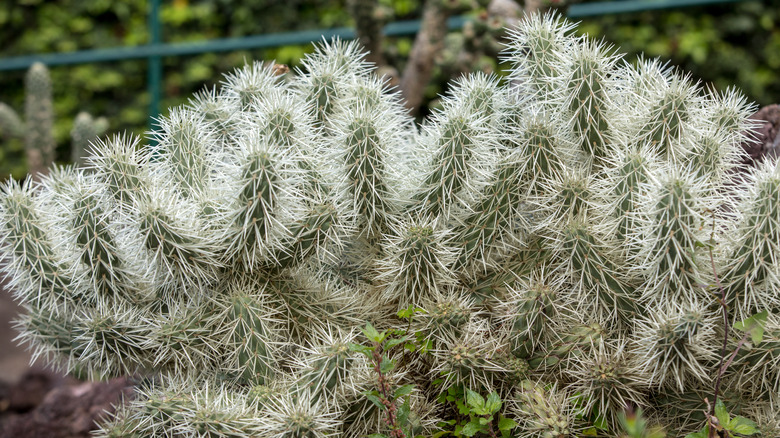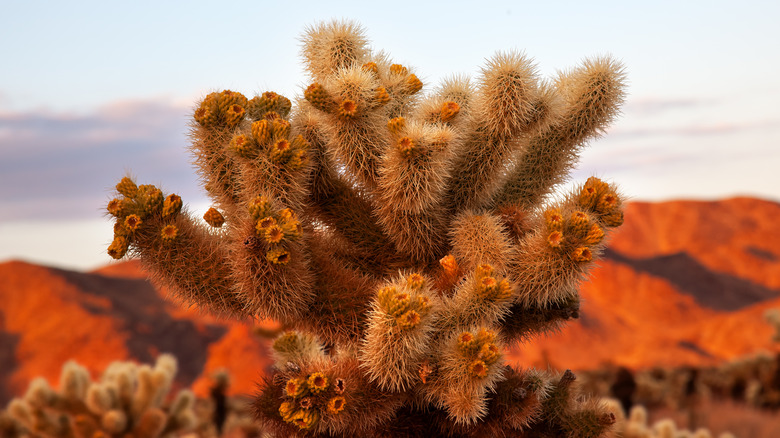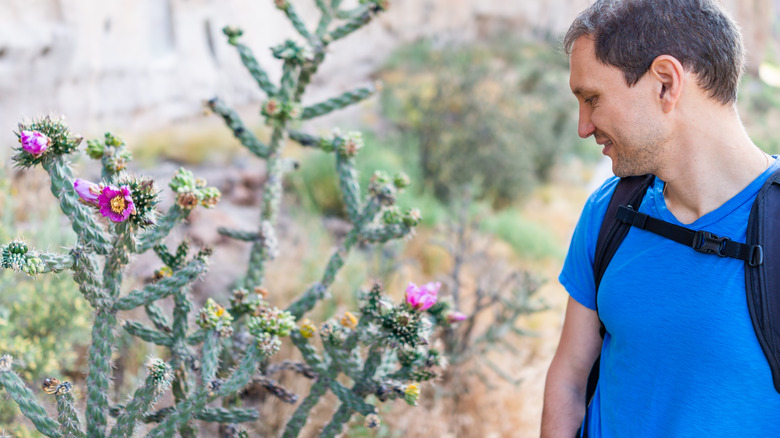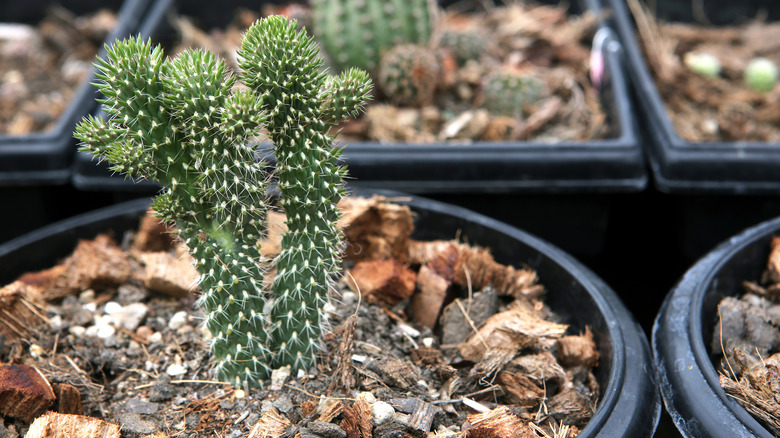How To Care For A Cholla Cactus
Cylindropuntia or cholla cactus used to be a part of the Opuntia genus until the shape of their stems set the two apart. A genus that included more than 20 distinct species before the cylindropuntia subgenus was made to stand on its own. Today, about 33 species of cholla cacti boast beautiful flowers, a range of height, and dangerous spines, as per GrowingVale. Some of these species include the Buckhorn Cholla, Jumping Cholla, Desert Christmas cactus, and the coveted Teddy Bear cholla. Each of these cacti in the Cylindropuntia genus can be grown at home or in the garden easily if you can provide them with the right conditions.
The cholla cactus can be identified by its cylindrical stems that feature segmented joints. All the branching makes this cactus appear marvelous from afar. Yet, when you get close, you notice all of its spiky tubercles and flowers that may appear yellow, pink, red, or orange. Different species of cholla cacti have other identifying characteristics; however, you can always bet on their multi-branching joints and edible flowering buds.
How to use a cholla cactus in the garden
Cholla cacti typically grow outside in parks or gardens, such as the Joshua Tree National Park in California. In an area like this, they grow tall and spread wide. However, it is not impossible to grow your cholla cactus right in your backyard or even inside your home. Only keep in mind that these plants are native to the arid deserts of northern Mexico and the southwestern United States, as told by GardenBeast. If you plan to grow a cholla cactus for pleasure, you must provide them with a similar climate.
Cholla cacti are sun-loving plants that will appreciate being planted in your garden where they can receive lots of direct light. They make great focal points in any yard as they can grow several feet high with little care. Though, you should ensure you don't plant your cactus near an area where children and pets frequently roam since the spines of cholla cacti are sharp and unforgiving.
How to grow a cholla cactus
Growing a cholla cactus is easy, especially when you buy it partially grown from a nursery. However, if you are looking for a bit of a challenge, propagating a cholla cactus from cuttings can be done. Before getting into it, you'll need some supplies. Be sure to gather protective gloves, cactus potting soil, a small pot, and a sterilized pair of scissors or a knife.
Start by cutting off some small branches from your cholla cactus when ready. They don't need to be larger than a few inches. When you've gathered as many cuttings as you'd like, place them all in a safe spot to dry out and callus, as explained by Expedition Homestead. When the cuttings are callused over, you may plant each of them into a pot filled with cactus potting soil so they may take root. It can take some time for this to occur. In the meantime, you should keep their soil moist as they adjust to their new environment. You can return to a regular watering schedule for your cholla cactus in about a week.
How to care for a cholla cactus
The cholla cactus is amazingly tough and drought tolerant making it an easy addition to any home or garden. But the plant has a few needs that must be met for it to survive. One thing that it requires the most is direct sunlight, and each day the cactus should receive at least six hours of full sunshine. This can easily be achieved by placing it in a south-facing window or planting it in a sunny spot in your yard, as described by GardenBeast. When keeping a cholla cactus outdoors, ensure the temperatures won't drop below 5 degrees Fahrenheit. Though these cacti are hardy, they prefer warmer temperatures that consistently stay between 50 and 70 degrees Fahrenheit.
Most of all, you'll want to keep this cactus in dry conditions. Too much water can cause irreversible damage to the plant from root rot or similar issues, and it only needs moisture when its soil has completely dried out. This usually means you'll need to water yours once weekly during hot seasons and seldom during colder seasons.
Cholla cactus varieties
All cacti under the Cylindropuntia genus are native to the hot, arid regions of the southern United States and northern Mexico. They feature sharp thorns from diamond-shaped tubercles, warm-colored flowers, and many branching stems. Though they share these common traits, each species shows off a different appearance. Let's look at some of the popular varieties, as outlined by GrowingVale.
- Cylindropuntia acanthocarpa 'Buckhorn Cholla' is a messy-looking cactus with branches that go every which way. People love this species for its brightly colored flowers and spiky green fruit.
- Cylindropuntia fulgida 'Jumping cholla' is also called the 'Chain Fruit cactus.' It is known for its ability to spread rapidly, which has given it the reputation of an invasive species in some parts of the world.
- Cylindropuntia leptocaulis 'Desert Christmas cactus' shows off bright red fruit that looks like little Christmas ornaments decorating the plant.
- Cylindropuntia imbricata 'Cane Cholla' is a smaller cholla cactus species only growing 8 feet tall in the wild. The variety is loved by pollinators who are attracted to its pink and purple flowers.
- Cylindropuntia bigelovii 'Teddy Bear cholla' is named after its fuzzy appearance from a distance. But don't be fooled; this commonly grown desert cactus is full of sharp spines.
Is the cholla cactus toxic?
Technically, the cholla cacti in the Cylindropuntia, formerly Opuntia, are non-toxic to animals such as horses, cats, and dogs, as the ASPCA says. Their flowers and fruits are edible and sometimes used as supplements for pregnant women and the elderly who are calcium-deficient, says GrowingVale. However, like many other cacti, cholla cacti are full of sharp spines, making them very dangerous.
Getting too close to a cholla cactus without being mindful of its spines can result in some pain and discomfort. Cylindropuntia protects itself with hundreds of thorns that easily detach from the rest of the plant and into a person's skin. These thorns can be tough to remove as they dig into your flesh and muscle. The best way to get them out is to use tweezers and pick each spine. Afterward, as per CactusWay, you should clean the wound and use Neosporin or another antibiotic ointment to prevent unwanted bacteria.
How to repot a cholla cactus
Cholla cactus don't need to be repotted often, and they are slow-growing, so it may take years before it requires more space. The supplies you'll need to begin the repotting process include a new pot, cactus potting soil, gloves, or another method such as newspaper to handle the cactus.
Start repotting by first making sure the soil beneath your cactus is dry. Dry soil will make removing the plant from its old pot easier and reduce transplant shock after repotting. Then, as shown by Desert Plants of Avalon, gently loosen the soil around the cactus either by squeezing the sides of the plastic container or using a knife around the edge where the pot meets the soil. Next, you can gently take the cactus out of its pot and work the excess dirt out of its roots to reveal and untangle them. Fill about a third of the new pot with fresh soil and place your cactus into it. Once it's in, you can backfill with more soil until it reaches the top of the container. Make sure to press the dirt firmly around the base of the cactus, so it doesn't fall over. Give your cholla cactus a few days to adjust to its new home before watering it for the first time. Afterward, you can care for it as usual.
